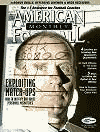AMERICAN FOOTBALL MONTHLY THE #1 RESOURCE FOR FOOTBALL COACHES
Article CategoriesAFM Magazine
|
Teaching WR\'s the Critical Skillsby: David Needs© More from this issue One of the main problems that have plagued football coaches for a long time is how to teach the necessary skills needed to play the game during the fifteen to thirty minutes in practice known as individual. Just at the wide receiver position, we must teach stance, start, footwork, route running, releases (press and open field), blocking (push blocking, wall-off, cutting, middle block), catching the ball, running with the ball, and many other skills needed to be a good wide receiver. There is a lot to be done and not enough time to do it. There are a number of great coaches who believe that individual time, where we teach and perform position skills, is the most crucial time for player development. My high school coach believed that if any thing should be sacrificed in practice it would be team time, because ind....The full article can only be seen by subscribers. Subscribe today!
|
|
|||||||
| HOME |
MAGAZINE |
SUBSCRIBE | ONLINE COLUMNISTS | COACHING VIDEOS |
Copyright 2025, AmericanFootballMonthly.com
All Rights Reserved





